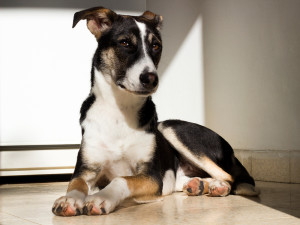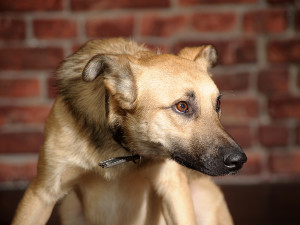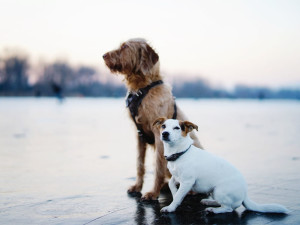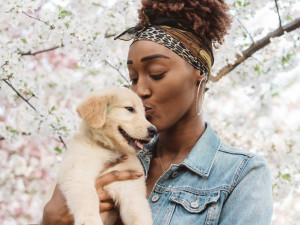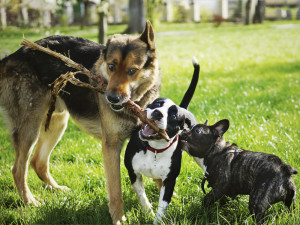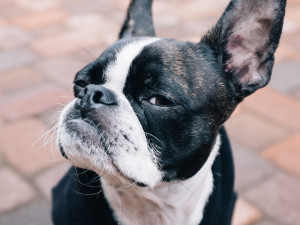How to Interpret and Stop Aggression in Dogs
Learn what causes this behavior and how you can help your pup.
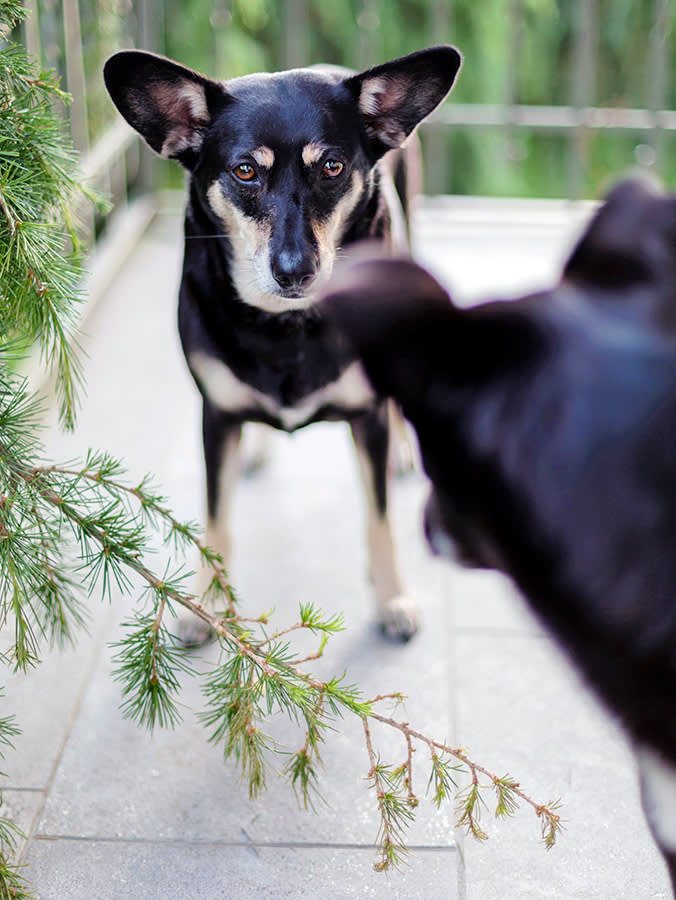
Share Article
In This Article:
Why Do Dogs Get Aggressive? Types of Aggression in Dogs How to Train an Aggressive Dog Frequently Asked Questions
Dog aggression is scary, and if left untreated, can be detrimental to the safety of humans and animals around. Aggression is not your dog trying to get dominance; that theory has been disproven.
Why do dogs get aggressive?
Dog aggression can stem from a variety of reasons. Some main reasons your dog may be showing aggressive behaviors are: fear; resource guarding or possessiveness; past dog attacks; protection; or pain or illness.
Causes of aggression in dogs
Lack of training: A dog who lacks proper training can be very impulsive, and this can cause your dog to act on instinct and without thinking during situations that are difficult for them, rather than looking to you for assistance. A dog who has positive-reinforcement training is more likely to look to their guardians for help when a tricky situation arises. Positive reinforcement creates a bond between you and your dog that fosters trust.
Lack of socialization: Dogs who have not been properly socialized may have a higher chance of displaying aggression. When dogs do not spend time around other dogs, they do not learn proper body language and cues, and so they have a hard time understanding dog communication. Unsocialized dogs will not be able to interpret the different signs and signals dogs use to communicate. This may confuse the other dogs interacting with the unsocialized dog, causing disagreements, which can then lead to aggression. An unsocialized dog may also be fearful of other dogs. Fear is a large cause of aggression in dogs.
Reacting to fear: Fear can be a large piece of dog aggression. Just like humans, dogs can go into fight or flight mode when scared. A dog will typically react with aggression when scared if they have no way out. If there is nowhere for them to go, their instinct is to do whatever they can to get away from what is scaring them. Dogs will typically use body language and show signs that they are uncomfortable before resorting to aggression. Fear aggression is used by dogs as a last resort to get the distance they need from whatever it is that scares them.
Dog attacks
From my experience, a friendly dog can become aggressive after they have been attacked by another dog. This can happen when you take your dog to a dog park or just a walk in your neighborhood. Dog parks are not for you to take your unsocialized dog to socialize. Unfortunately, that is what many people use them for. When an unsocialized dog is taken to a dog park to make friends, disaster can happen. Dog parks can be overstimulating to even the friendliest, most social dog. When you bring a dog who does not understand social cues to the park, it can cause a lot of miscommunication between dogs. As a result, this can cause fear and aggression to happen.

If you have a puppy, it is important to expose your puppy to stable, social adult dogs. By doing this, you will have a great chance of helping your puppy learn how to be a stable and social puppy and adult in the future.
Puppies are very impressionable, and there are fear periods during puppyhood. Puppies can be overzealous, and not all adult dogs enjoy puppy energy. Stable social adult dogs can teach your puppy the ropes through appropriate behaviors and corrections. When you introduce your puppy to a dog whose temperament you do not know, you risk the chance of letting them interact with a dog who does not have appropriate manners.
This could lead to a dog fight, because your young puppy does not have an understanding of dog body language. Puppies are very impressionable. A dog fight may lead your puppy to become fearful of dogs. If your puppy or dog is attacked by another dog, it is a good idea to get them around other well-mannered dogs shortly after the incident.
Types of aggression in dogs
Dog aggression can show up in many areas of daily life, but it can be preventable if you know the sights and sounds to look for. Dog aggression does not normally come out of nowhere. Usually, there are telltale warning signs that help you know it is coming.
Understanding dog body language and knowing what to look for is the best way to have a better idea of what your dog is thinking. Some signs that aggression is looming include: ears pinned back; stiff body; harsh stare; growling; teeth baring; lip licking; snapping; or a tucked tail. Typically dogs follow a “dog-aggression ladder.” As they work their way up the ladder, they get closer and closer to possible aggression.
Resource guarding
Resource guarding is a normal dog behavior. Dogs may guard the bed, food, toys or people. Resource guarding may look like one dog growling at another dog while they walk by as they are eating. When they do that, your dog is telling the other dog to stay back. Resource guarding becomes a problem when your dog does not listen to cues.
When a dog is pushed to the limit and feels like the resource is going to be taken away from them, they may react with aggression. You can help your dog work through these emotions with specific training. You will first want to start with management techniques to prevent the behavior from happening while you contact your vet and a trainer. These management techniques may include: keeping dogs separate; baby gates; or muzzles. Positive reinforcement, as well as counter-conditioning and desensitization (see below for more information), can help a dog get more comfortable being around resources.
Fear
Fear aggression happens when a dog is at their wit’s end and may feel like there is nowhere for them to go to get away from what is scaring them. When this happens, they will resort to aggressive behaviors to get away.
Predatory instincts
Dogs are descendants of wolves, and even though they have been domesticated for many years, they still possess an innate interest in hunting. Typically, squirrels, rabbits, birds, or rodents will fall prey to this, but small dogs can also be at risk.
If you notice your dog stalking, intensely staring, pouncing, or chasing, it is time to intervene. Once they have gotten ahold of the animal, it may die. You can help prevent this from happening by fulfilling your dog’s predatory behaviors in appropriate ways. Using a flirt pole is a great way to help your dog act out their predatory energy in a safe, constructive way.
Marking territory
Marking territory is a way for dogs to communicate. When dogs mark something with their urine, they can communicate their gender, age, and health, and show that they have been there or that the space is theirs. You may notice your dog marking more if you bring home a new pet. Keep an eye on this behavior and observe if you notice any other signs that your dog is uncomfortable. These could be the beginning stages of aggression.
Responding to punishment
Using punishment to train your dog can cause your dog to become aggressive. When using punishment, you are training your dog to do a behavior (and if they don’t, the message is that something bad will happen). Depending on your dog’s temperament, they may become aggressive after a punishment has been used on them. When you use punishment, you may cause your dog to become fearful or develop anxiety, which can make them more aggressive. By using positive reinforcement and rewarding your dog for good behavior, you can avoid causing them anxiety or stress.
Health
When a dog is hurt, they may not act like themselves. I have seen this first-hand. My lovable dog Boss, who is a loyal, calm and collected cuddle bug, got injured and seemed to become a different dog. When running down the stairs after a squirrel, his toenail got caught and was ripped halfway off. He returned to the kitchen, and I noticed a large amount of blood. When we figured out what was wrong, we went to try to stop the bleeding and bandage him up before taking him to the vet.
When we went to do this, he turned and snapped at my husband because of the amount of pain he was in and the fear he had that we might try to touch his paw. Luckily, he is muzzle-trained, and so we were able to muzzle him to get him bandaged up and safely to the vet.
Muzzle-training your dog is a great way to prepare for the unknown and to make sure everyone is safe if there ever is an injury. You can always put a muzzle on a dog, but if you train your dog to wear it before the emergency, this is one less thing that will be stressing them out during an already stressful situation.
How to train an aggressive dog
See a vet first.
It is important to seek the help of a veterinarian when you notice your dog’s aggressive behavior. Your vet may be able to point out a medical reason why your dog is acting aggressively. The vet can prescribe medication to help ease your dog’s anxiety or pain that may be causing the aggression. Your vet may also have recommendations for dog trainers that specialize in aggression.
Work with a certified trainer.
Find a trainer who specializes in aggression. Not every dog trainer works with aggressive dogs. It is important to work with a dog trainer who is familiar with aggressive dogs; their practices will keep everyone safe.
Understand why your dog becomes aggressive.
Try to take notes when you notice your dog becoming aggressive. Be observant and think ABCs: antecedent (what happens first), behavior, and consequence (what happened next).
This information will help you, your vet, and your trainer gain a better understanding of why your dog is acting aggressively. Once you have a better understanding of the reason behind it, you will be able to figure out the best ways to help your dog.
Provide exercise and stimulation.
Exercise and stimulation can help properly provide your dog with outlets to help curb their energy and give them appropriate ways to engage in natural dog behaviors. Allow your dog to dig in the sandbox or dirt. Use a flirt pole to safely engage their prey drive. Hide toys or treats for them to find around the house so they can scavenge. Give them bones or frozen chews to practice pulling apart and gnawing.
Identify triggers for aggressive behavior.
An important part of the dog aggression puzzle is what causes your dog to act out in aggressive behaviors. To help your dog overcome these behaviors, you have to know why they are happening. Keeping a log book of when the behaviors happen, as well as what happened before and after, will help you and your team figure out the best treatment plan for them.
Desensitize them and work on counter-conditioning.
Desensitization means making your dog less sensitive to the trigger. With the help of a trainer, you can work on exposing your dog slowly in small increments to help your dog become more comfortable with the trigger.
Counter-conditioning pairs with desensitization to help your dog become more comfortable around their triggers and feeling confident. Counter-conditioning pairs what your dog likes or enjoys with something they are not thrilled with. The slow exposure helps them pair something they love with something they don’t enjoy, which allows them to change their response over time growing more comfortable and confident around something that triggers them.
Use positive reinforcement.
From my experience, a combination of desensitization, counter-conditioning, and positive reinforcement can help dogs in many ways.
When you have a fearful or aggressive dog, using punishment continues to make things worse, the dog learns they should be scared of their parents. Dogs do not understand us when we speak; they instead heavily rely on body language. So, when we use punishment to try to teach them something, all we are teaching them is that a normal dog behavior caused their owner to hurt them or yell, and they do not know any better. All they are learning is that their owner is impulsive and scary. Most of the time, the dog will not understand that they are being punished for what they just did. Especially if your timing is off even by a few seconds.
Positive reinforcement allows you to teach your dog the right thing from the start. This helps build the dog’s confidence and foster a good relationship with them. You’ll create a dog who willingly wants to do things with and for you, such as responding to their name, standing for brushing, listening to the command “leave it,” and more.
Manage aggression.
While you are working with the assistance of a trainer and your vet, it is important to manage your dog’s aggression. But that can be a slow process. During that time, you want to prevent your dog from engaging in this behavior as much as possible. The more they realize reacting with aggression gets them what they want, the more the behavior becomes engrained and more difficult to work out. Managing aggression is the best way to keep everyone safe.
Use indoor gates: Using gates to separate dogs who don’t get along, a dog from a new baby, or dogs during feeding time will keep everyone safe. Indoor gates can be used to give everyone the space they need to feel secure. Gates can also be used during training to give you a safety net in case of an accidental training fail.
Keep your dog leashed: Leash laws should always be followed. Allowing dogs off-leash in areas with leash laws is a recipe for disaster. People with possibly aggressive or unfriendly dogs still have a right to go to areas with leash laws. If your friendly dog does not respond to your call and runs up to the leashed dog, that could be a disaster.
Unfortunately, this is a great way to also turn friendly dogs into cautious or unfriendly dogs. Over the years, this has happened to my leashed dogs a number of times. Random dogs with no manners run up to my pups, with their owners either nowhere to be found or yelling, “Don’t worry, they are friendly!” I have noticed over the years that my dogs have become less and less tolerant of this. Leashes are a great way to keep your dog safe not only while out and about, but also in your house or in your yard to help give you distance while working on training.Find empty outdoor space: Your dog with difficulties still deserves to have a fulfilling life. Try to find empty spaces where you can take your dog where they won’t see their trigger. This will help them get exercise and stimulation safely.
Muzzles: Muzzles are a great way to safely allow your dog to have a bit more freedom while making sure everyone is safe. Muzzles may look a little scary, but they are a great tool with many uses. Muzzles can keep your dog from eating things they shouldn’t, keeping others safe if they are in pain or injured, and, most of all, keeping your dog from biting.
This is a great thing to train when you first get your new puppy. Start by getting them comfortable with the muzzle, rewarding them for looking at it, and touching it with their nose or paw. Once they are willingly doing that, you can begin to introduce them to sticking their nose in the muzzle. Put some peanut butter on the muzzle and allow them lick it off, starting on the opening of the muzzle and working your way further in. Now that they are OK with sticking their nose in, have them stick their nose further inside and reward them with a treat through the holes of the muzzle.
Continue to do this, each time waiting a few seconds before rewarding them and increasing the amount of time they wait before getting a treat. Then, you will need to work on your dog putting their nose inside the muzzle and having it buckled over their head. You may need to work on getting them used to the buckle sound on its own, depending on how sensitive your dog is. Once your dog is comfortable wearing the muzzle, do things they enjoy while they are wearing it. Starting with small increments, have them wear it for a few minutes while on a walk, and continue to work your way up to the entire duration.
FAQs
What are triggers for aggression in dogs?
Each dog will have different types of triggers. Other dogs, loud bangs, someone yelling or raising their arms or fists, or coming near them when they are eating are some of the reasons a dog may feel the need to become aggressive.
Can you train an aggressive dog at home?
Aggression is a serious behavior in dogs that can cause harm or, at worse, death. It is best to seek the assistance of a veterinarian and dog trainer. Once your dog’s aggression is under control, you can begin to work on maintaining behaviors at home under the supervision of a trainer.
What are the causes of aggressive dog behavior?
Some causes of aggressive behavior in dogs include resource guarding, pain or illness, and fear — to name a few.
Does growling lead to aggression?
Growling is your dog’s way of telling you they do not like what is happening, and they want space. Growling is on the ladder of aggression and is a few steps away from biting. If your dog growls, it is best to understand why they are growling and listen to what they have to say. Give them some space and time.
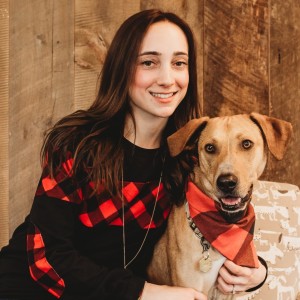
Danielle Vrabel, CPDT-KA
Danielle Vrabel is a dog trainer who earned her CPDT-KA in 2020. Danielle is a proud pet mom of five pets: two dogs, two cats, and a corn snake. Danielle has fostered over ten dogs and fifteen cats and kittens, as well as helped train shelter dogs before they are adopted. Both of Danielle’s dogs are pet therapy dogs, where she also volunteers her time helping evaluate future therapy dogs.
Related articles
![Owner serving dog food]()
Your Dog’s Food Aggression Isn’t Cute — Here’s How You Can Work On It
No longer associate feeding time with growling time.
![Big and small dog standing together at a park]()
Big dogs, Small dogs: Does Size Affect Behavior?
How is the experience of having a large dog different than that of having a small dog?
![woman draped in an orange blanket holds a black-and-white puppy]()
5 Development Stages You Should Know When You Get a Puppy
It’s like What to Expect When You’re Expecting, except add “four little paws to run around your house” to the title.
![Three dogs biting a stick.]()
Some Like It Rough: Playing Vs. Fighting
Two animal behavior experts agree it’s usually play fighting. Here’s how you can tell.
![Boston terrier being stubborn]()
Dog Training — DIY or Hire a Pro?
When it’s time to call in reinforcements.
![Pet parent comforting anxious dog by holding their paw]()
How to Help an Anxious Dog
Easy ways to calm your pup’s nerves.

